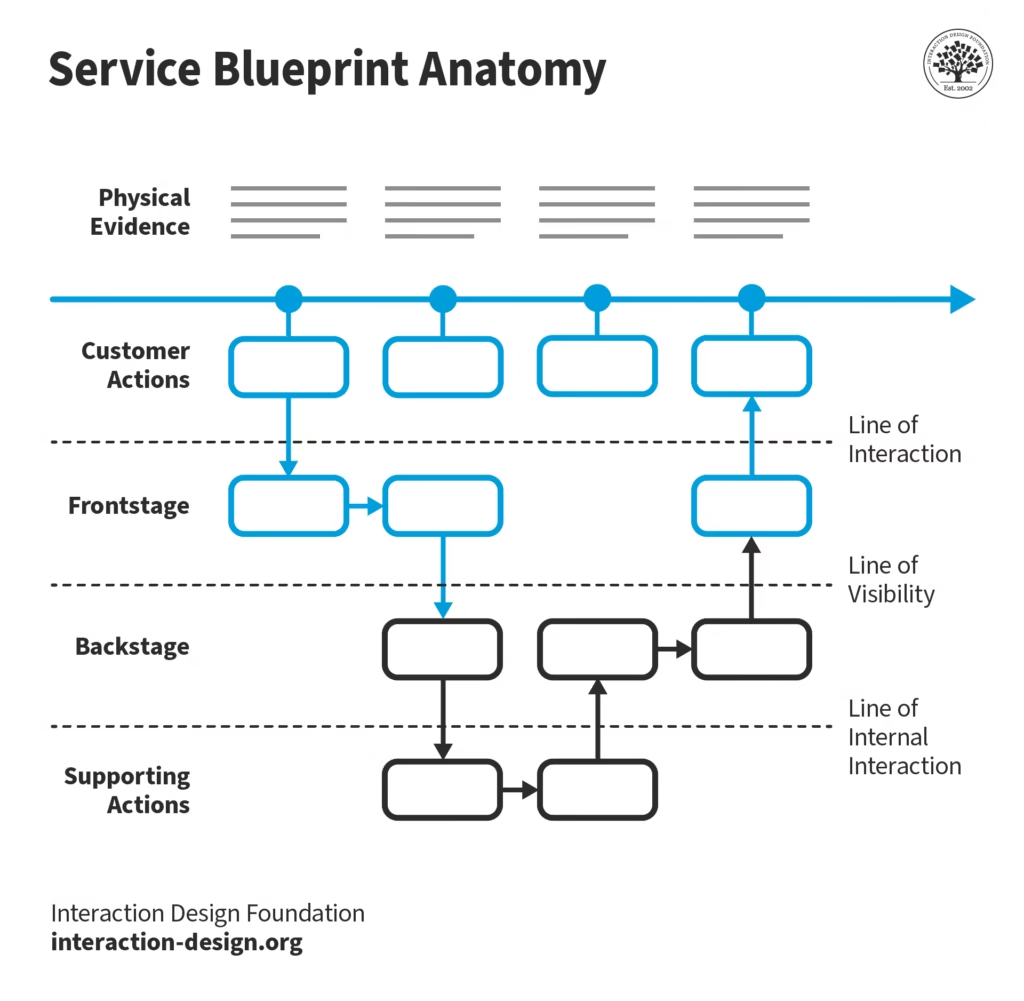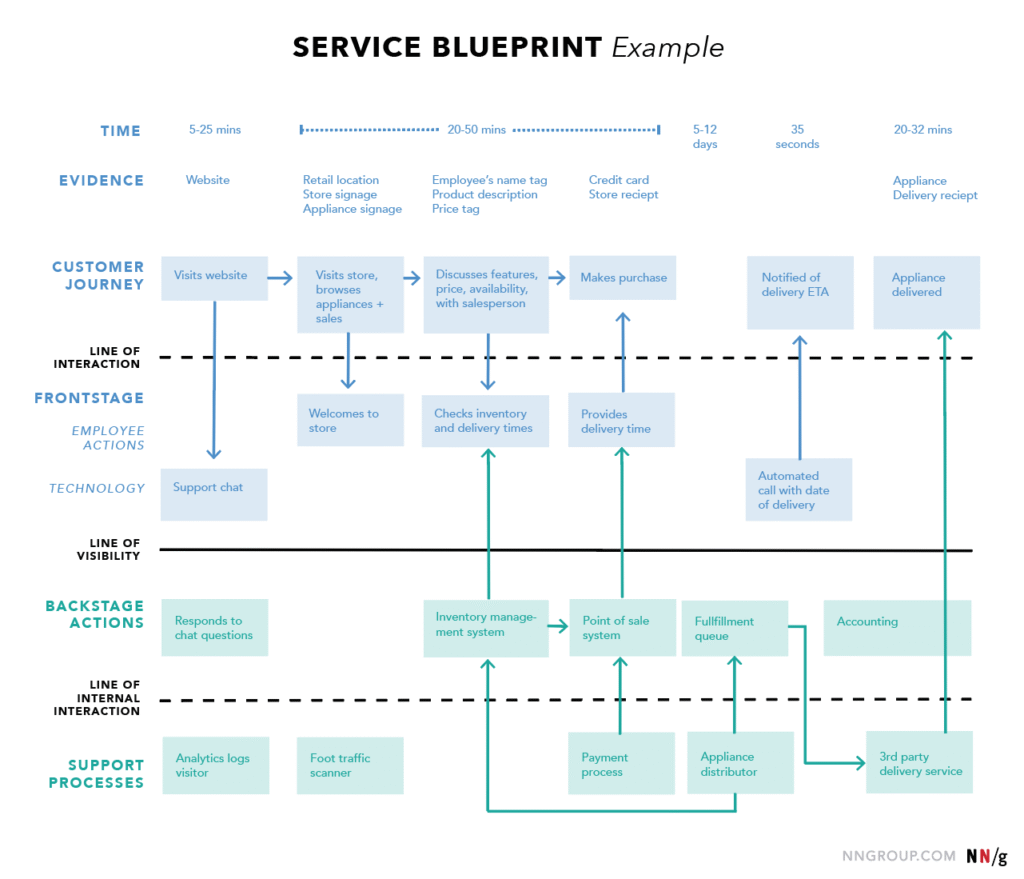Let’s imagine the experience in a restaurant. The customer orders a dish that takes 40 minutes to arrive, cold. To them, it’s poor service. But what really happened? Perhaps the order never reached the kitchen due to a system failure (a support process), or the kitchen was overwhelmed due to a lack of staff (a backstage issue), and no one in the dining room (frontstage) realized it in time to manage customer expectations.
The poor customer experience was just the tip of the iceberg. The real problem was hidden in the operation. And therein lies the power of the Service Blueprint: it’s the map that allows us to see the entire operation, both what the customer sees and what happens “behind the scenes,” to understand how each piece impacts the final experience.
At BLASTER, we don’t just design the visible customer interaction; we orchestrate the entire system that supports it. The Service Blueprint is our essential tool for connecting the dots, aligning teams, and designing services that run flawlessly, inside and out.

Image courtesy: Service Blueprint – Interaction Design Foundation.
What is a Service Blueprint and how does it improve customer experience?
While a Customer Journey Map focuses on the customer’s perspective (their steps, emotions, and thoughts), a Service Blueprint goes a step further: it connects that customer journey to the company’s internal actions and processes that make the experience possible. It’s the blueprint for how a service is delivered.
A Blueprint is divided into key components, separated by “interaction lines”:
- Physical Evidence: The tangible elements the customer encounters. E.g., an app interface, a restaurant menu, a confirmation email.
- Customer Actions: The steps the customer takes as part of the service. E.g., clicking “buy,” asking the chatbot a question, arriving at the branch.
- Frontstage Actions: What employees or systems do in direct contact with the customer. E.g., the receptionist greeting them, the chatbot’s automated response.
- Backstage Actions: What employees do to support the frontstage, but without being seen by the customer. E.g., the chef preparing the food, the analyst processing a request.
- Support Processes: The systems, vendors, or internal steps that support employees. E.g., inventory software, the payment system, company policies.

Image courtesy: Service Blueprint example from Nngroup.
What is the real impact on your business?
Innovation isn’t just about having a good idea, it’s about being able to execute it excellently. The Service Blueprint is the key tool for achieving operational excellence.
A well-designed Service Blueprint isn’t just a roadmap; it’s a powerful tool for identifying and improving key aspects of your service. Its real value lies in the following:
- Reveal the root cause of problems: It allows you to identify exactly where the chain breaks down. Is a customer friction point caused by poor training (backstage) or slow software (support process)? The blueprint shows it.
- Align the entire organization: Teams that don’t normally talk to each other (such as marketing, operations, and technology) can see on a single page how their work directly impacts each other’s work and the ultimate customer experience. The Service Blueprint aligns all teams, showing them on a single page how their work directly impacts service and customer satisfaction.
- Acts as a roadmap for innovation and efficiency: By visualizing the entire process, you can easily identify opportunities to automate tasks, eliminate redundancies, reallocate resources, and create new moments of value for the customer.

Getting Started: How to Build a Service Blueprint in 5 Steps
Creating a Service Blueprint is a collaborative exercise that unites different areas of the company. At BLASTER, we facilitate these sessions to ensure a complete view.
Step 1: Define the Scenario and the Customer. Choose a specific service and a specific customer archetype. You can’t map everything at once. Example: The “return a product” process for a “first-time online shopper.”
Step 2: Map the Customer Steps. First, trace the customer journey from start to finish. This will be the backbone of your blueprint.
Step 3: Draw the “Frontstage.” For each customer step, map the direct interactions they have with your company (people, technology, etc.).
Step 4: Connect the “Backstage” and Support Processes. Now, reveal what happens “behind the scenes.” What internal actions or systems are needed for each frontstage interaction to happen? Draw the connections.
Step 5: Identify Frictions and Opportunities. With the map complete, mark pain points, bottlenecks, and inefficiencies. These are your starting points for optimization and innovation.
How can a Service Blueprint transform your business?
At BLASTER, it’s a fundamental part of our Service Design service because it allows us to move from understanding to action. We use it to help our clients answer critical questions: Where should we invest to improve customer satisfaction? How can we reduce operating costs without sacrificing quality? What technology would help us be more efficient?
It’s not just about drawing a map, but about interpreting it to make smarter business decisions. Discover the hidden frictions and opportunities in your operations. Write to us and let’s talk about your project.